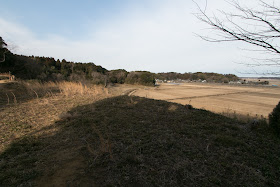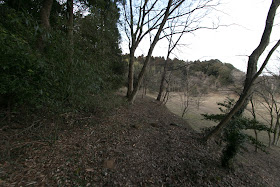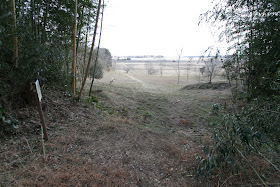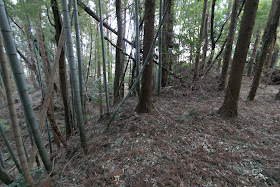Motosakura Castle
-Castle consists of old inner area and advanced outer area-
Overview
Name: Motosakura Castle (Motosakura-jo)
Alias:
Place: Osakura Sakura city / Motosakura Shisui town, Chiba
Type: Hill Castle
Built: Originally in 1469, expanded in 1580's
Remaining remnants: Clay walls and dry moats
Title: 100 more famous Japanese castles
Brief History
Motosakura castle (本佐倉城) is located on a long and narrow hill of 30 meter height protrudes into the rice field, located at 2 kilometer east of current Sakura castle.
Due to land reclamations performed in modern age current castle site is far from Lake Inbanuma, but formerly the castle directly faced Katori sea, a huge inner sea contained current Lake Kasumigaura, Lake Teganuma and Lake Inbanuma, and divided current Chiba prefecture and Ibaraki prefecture. Formerly a major road run from current Chiba city to Choshi area, the mouth of Tonegawa river passed along with the south coast of Katori sea, and the place of Motosakura castle was a connecting point of water transportation at Katori sea and this road.
A traditional clan of Chiba area
Motosakura castle was built by Chiba clan in 1469. Chiba clan, which was the origin of Chiba prefecture, was a traditional clan stem from Yoshifumi Taira (?-?), a descendant of Emperor Kanmu (781-806) and one family of Taira clan. Chiba clan moved to Chiba area in 11th century and built Inohana castle at Inohana hill at the center of current Chiba city.
Tsunetane Chiba (1118-1201) supported Yoritomo Minamoto (1147-1199), the founder of Kamakura shogunate and activated at many battles such as the battle of Fujikawa in 1180 or the battle of Ichinotani in 1184. As a reward for his contribution, Chiba clan once held Shimousa province (western part of Chiba prefecture) and Kazusa country (upper half of Boso peninsula) and became a major lord under Kamakura shogunate.
But on and after the middle period of Kamakura era, continuous internal conflicts occurred in Chiba clan, and whenever discord arouse Chiba clan lost their power. Although Chiba clan was regarded one of eight traditional clan in Kanto region along with Utsunomiya clan or Satake clan, but main stream of the clan disappeared in the middle of 15th century and Chiba clan became the puppet of its vassal Hara clan.
Motosakura castle was built under such confusing situation by Suketane Chiba (1421-1492) in 1469. Later each leader expanded this castle, and this castle became a huge castle of 800 meter length and 700 meter width. The overall structure of this castle is a reverse L letter shape, and main areas were built at the narrow hill protruded into the marsh toward east. From inside there are central area, Okunoyama area and Kuraato, and these areas are not so shaped but guarded by rough and steep slope of about 10 meter high. These areas are thought as original castle area built by Chiba clan.
Disorder of Chiba clan and expansion of the castle
In the 16th century, Chiba clan was involved into political conflict of Koga Kubo highness, a political authority of this area and located near Chiba clan, and further declined. Among the situation surrounding warlords such as Satake clan or Satomi clan aimed at the territory of Chiba clan, Chiba clan asked assistance to Hojyo clan, a strong warlord of Sagami province (Kanagawa prefecture) and seized large part of Kanto region. Even though weakened, Chiba clan had still certain authority and Hojyo clan supported Chiba clan to expand their influence to this area.
Under the support of Hojyo clan, Tanetomi Chiba (1527-1579), the leader of the clan, repeatedly drove back the invasion of Kenshin Uesugi (1530-1578), a brave warlord of Echigo province (Niigata prefecture) who frequently intruded into Kanto region or Satomi clan, and made name of himself to neighbor area.
But after the death of Tanetomi, Chiba clan became confused again, and next leader was assassinated in 1585. Facing this situation, Chiba clan finally became controlled by Hojo clan directly. Leader of the clan was sent to Odawara castle (Kanagawa prefecture), the main base of Hojo clan, and at last son of Ujimasa Hojo (1538-1590) was nominated as the leader of the clan. However, Hojo clan itself was extinguished by central ruler Hideyoshi Toyotomi (1537-1598) by Odawara campaign in 1590, and Chiba clan shared the fate with Hojyo clan.
Under Hojyo clan, outer area was expanded. At first, in front of old areas an area named Setteiyama was built. This means hosting place, and is thought to be the place prepared for the commander of Hojo clan. This area is located at the base of height and guarded specially steep clay walls. Furthermore, large outer barriers protected by wide dry moat were built at the connecting height toward southward, and another fort prepared as a starting point of counter attack was made opposite of the marsh. At this stage, the character as a military base of Hojo clan was strengthened rather than the residence of Chiba clan.
Afterward of the castle
After the extinction of Hojyo clan, Kanto region was given to Ieyasu Tokugawa (1543-1616) by Hideyoshi. As an important place Ieyasu placed his fifth son Nobuyoshi Takeda (1583-1603). NObuyoshi used this castle as residence, but died in youth. Later Toshikatsu Doi (1573-1644), grand minister of Edo shogunate, became the governor of this area. Toshikatsu started to build a new castle at neighbor place and moved to new Sakura castle, thus Motosakura castle was abolished at that time.
Currently the shape of central areas well remains on the hill, and inner areas are maintained as a historical site. Not so sophisticated but dreadfully steep walls of central areas seen from entrance of the castle shows the power and authority of traditional clan, even though weakened.
Access
15 minutes walk from Keisei-Honsen line Osakura station. Motosakura bus stop of Chiba Green bus connects Keisei Sakura station and Keisei Shisui station. 20 minutes drive from Higashi-Kando Jidoshado Expressway Shisui interchange.
Related Castles
Sakura Castle -Official residence of ministers of Edo Shogunate-






























































































































































































































































































No comments:
Post a Comment